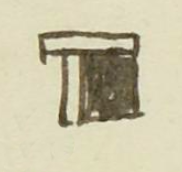Tlilquiyahuac (MH647r)
This compound glyph for the personal name Tlilquiyahuac ("Black Entrance" or perhaps "Dark Outside"), attested here as a man's name, shows a profile view of two perpendicular wooden beams that form something of a T-shape. They are facing toward the viewer's right. These are the classic beams that are found on the Nahua hieroglyph for house or building (calli, playing a semantic role here), and therefore they can convey the sense of outside or entrance (quiyahuac). A square of black paint fills in the right side of the T, providing the color black (tlilli), which is at the start of the name.
Stephanie Wood
If the gloss is accurate to not be ending in "c," then the entrance may be a phonetic indicator for quiyahui or quiyahuitl (rain), and the name would then be "Black Rain."
The gloss identifies a Christian first name (Toribio). He may have been named after Toribio de Benavente, also known as Motolinia ("One Who is Poor or Afflicted"). This was the first word he learned in Nahuatl, and he went on to learn the language well. He lived in the monastery in Huejotzingo. Doing a quick search for the name "Toribio" will produce an impressive result.
Stephanie Wood
toribio tlilquiahua
Toribio Tlilquiyahuac
Stephanie Wood
1560
Jeff Haskett-Wood
casas, edificios, entrada negra, afueras, nombres de hombres

tlil(li), black or black ink, https://nahuatl.wired-humanities.org/content/tlilli
quiyahuac, outside or at the entrance, https://nahuatl.wired-humanities.org/content/quiyahuac
quiyahui(tl), rain, a day name, https://nahuatl.wired-humanities.org/content/quiyahuitl
Entrada Negra
Stephanie Wood
Matrícula de Huexotzinco, folio 647r, World Digital Library, https://www.loc.gov/resource/gdcwdl.wdl_15282/?sp=376&st=image
This manuscript is hosted by the Library of Congress and the World Digital Library; used here with the Creative Commons, “Attribution-NonCommercial-ShareAlike 3.0 License” (CC-BY-NC-SAq 3.0).




